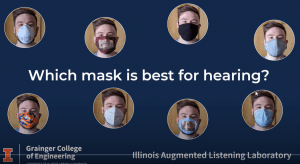Ryan Corey, Ph.D., post-doctoral fellow and engineer at the University of Illinois at Urbana-Champaign, has quantified what we have all been experiencing since donning masks at the onset of the Covid-19 pandemic. Face covering materials such as masks give all listeners the equivalent of at least a mild hearing loss by filtering out high frequency, unvoiced, fricative sounds (such as k, s, sh, f, th), as well as distorting other parts of speech. In addition to the loss and distortion of auditory information, visual cues for speech reading are lost making hearing, especially at a distance and in noisy environments, difficult. Factor in the college level content, new vocabulary, and fast-paced classroom interaction, students may experience fatigue and frustration and be missing critical learning opportunities.
 This short video demonstrates the acoustical impact of a variety of masks: “Which Mask Is Best for Hearing?”
This short video demonstrates the acoustical impact of a variety of masks: “Which Mask Is Best for Hearing?”
In addition to striving to increase the acoustical transparency of your mask, you should consider these other general communication strategies that may facilitate access to instruction and classroom discussion:
- Face students when speaking (pause when writing on the board or looking down at reference materials)
- Provide visual materials to support verbal instruction when possible
- Encourage students to identify themselves as speaker
- Repeat important concepts and student comments in class
- Reduce background noise by closing the door
- Consider reducing what else makes noise such as HVAC, fish tanks, Bunsen burners, etc.
- Create a supportive environment where asking questions and seeking clarification is encouraged
For additional information on this topic please visit https://www.asha.org/public/communicating-effectively-while-wearing-masks-and-physical-distancing/
Dr. Kate Salathiel, Au.D.
Educational audiologist, guest contributor and Kristen’s sister

